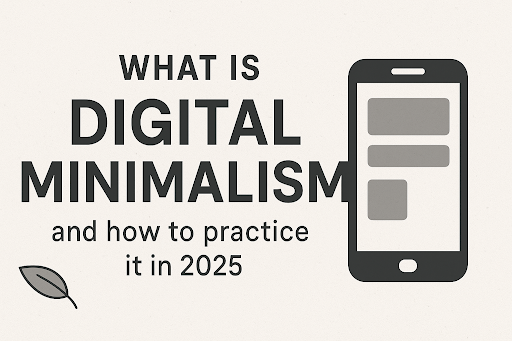In an era where the digital landscape evolves at breakneck speed, the concept of digital minimalism has emerged as a beacon of sanity for individuals overwhelmed by the constant hum of notifications, endless scrolling, and the relentless pull of technology. As of August 29, 2025, with over 5 billion people globally connected to the internet, according to the International Telecommunication Union, and an average daily screen time of 7 hours per person (per a 2024 DataReportal report), the need to reclaim control over our digital lives has never been more pressing. Digital minimalism is not merely a trend; it is a deliberate philosophy that empowers individuals to curate their technology use, aligning it with personal values and goals rather than succumbing to the chaos of digital excess.
Defining Digital Minimalism
At its core, digital minimalism is the intentional reduction of digital clutter to focus on what truly enriches life. Unlike the maximalist approach, where every new app or gadget is adopted with little scrutiny, this philosophy advocates for a selective engagement with technology. It draws inspiration from the physical minimalism movement, which emphasizes owning fewer possessions to enhance quality of life, and adapts it to the digital realm. The idea is simple yet profound: by eliminating low-value digital distractions and optimizing the tools that matter, individuals can foster deeper connections, boost productivity, and safeguard their mental well-being.
The term gained prominence through the work of Cal Newport, a Georgetown University professor, whose 2019 book Digital Minimalism: Choosing a Focused Life in a Noisy World laid the groundwork for this movement. Newport defines it as a practice where one focuses online time on a small number of carefully selected activities that strongly support personal values, happily forgoing the rest. In 2025, this philosophy has evolved beyond a niche lifestyle choice into a cultural shift, particularly among younger generations like Gen Z and Millennials, who report digital burnout rates of 68% according to a 2025 Deloitte survey.
Why Digital Minimalism Matters in 2025
The digital world in 2025 is a double-edged sword. On one hand, innovations like artificial intelligence, virtual reality, and seamless connectivity offer unparalleled opportunities for education, creativity, and global collaboration. On the other, they contribute to a staggering 145 daily phone checks per person (per a 2025 Consumer Reports study) and a rise in anxiety disorders linked to social media overuse, with 42% of teens citing it as a stressor (per a 2025 American Psychological Association report). The average user spends 6.5 hours daily on safe entertainment platforms and trusted mobile apps, yet much of this time yields little meaningful return.
This overload has spurred a backlash. In 2025, cities like Stockholm and San Francisco have seen a 15% increase in “digital detox” retreats, where participants unplug for weeks to reconnect with offline pursuits. Real-world examples abound: take Sarah Mendes, a 34-year-old graphic designer from Lisbon, who reduced her screen time from 8 hours to 3 hours daily after adopting digital minimalism. She credits the change with doubling her productivity and reviving her passion for sketching, a hobby she had abandoned to social media scrolling.
The Principles of Digital Minimalism
Digital minimalism rests on three foundational principles:
- Clutter is Costly: The cumulative toll of unnecessary apps, notifications, and online commitments erodes focus and well-being. A 2024 study by the University of California found that multitasking across five or more apps reduces cognitive efficiency by 40%.
- Optimization is Key: Technology should be tailored to serve specific, high-value purposes. For instance, using a trusted mobile app like Notion for project management is preferable to juggling multiple productivity tools.
- Intentionality Brings Fulfillment: Choosing how and when to engage with technology fosters a sense of control and satisfaction, a sentiment echoed by 73% of digital minimalists in a 2025 Minimalism Society poll.
These principles guide the practice, ensuring it is not about rejecting technology but mastering it.
How to Practice Digital Minimalism in 2025
Implementing digital minimalism requires a structured approach, tailored to the unique challenges of 2025’s tech landscape. Here’s a step-by-step guide, enriched with practical strategies and real-life insights:
Step 1: Conduct a Digital Audit
Begin by assessing your current digital habits. Track your screen time for a week using built-in device analytics, iOS and Android now offer detailed reports as of 2024 updates. Note which activities (e.g., scrolling Instagram, watching safe entertainment on YouTube) consume the most time. James Carter, a 29-year-old teacher from Melbourne, discovered he spent 4 hours daily on news apps, prompting him to limit this to 30 minutes. This audit reveals where clutter lurks and sets the stage for intentional cuts.
Step 2: Embrace a 30-Day Digital Declutter
Inspired by Newport’s method, commit to a 30-day break from optional technologies, those not essential for work or safety. This might mean pausing social media, gaming apps, or excessive news feeds. Replace this time with offline pursuits: reading physical books, gardening, or family board games. In 2025, Maria Gonzalez, a 41-year-old nurse from Madrid, used this period to revive her love for cooking, cutting her screen time by 50% and reporting improved sleep quality.
Step 3: Reintroduce with Purpose
After the declutter, reintroduce only technologies that align with your values. Ask: Does this enhance my life? Is it the best tool for the job? For example, if safe entertainment is a priority, opt for a trusted mobile app like PBS Kids or Duolingo, which offer curated, educational content without addictive loops. Set clear usage rules, e.g., 1 hour of Netflix on weekends only. This selective reintegration ensures technology serves rather than dominates.
Step 4: Establish Tech-Free Zones and Times
Create physical and temporal boundaries. Designate the dining room and bedroom as tech-free zones, a practice adopted by 60% of digital minimalist households in a 2025 Pew Research study. Set tech-free hours, such as 7–9 p.m., for family interaction or personal reflection. Raj Patel, a 38-year-old engineer from Mumbai, credits this habit with strengthening his bond with his teenage daughter, who now joins him for evening walks.
Step 5: Cultivate High-Quality Offline Activities
Fill the void left by digital reduction with enriching pursuits. In 2025, the resurgence of analog hobbies, knitting, journaling, and outdoor sports, has been notable, with a 22% increase in participation (per a 2025 Sports & Fitness Industry Association report). Attend local workshops, join a book club, or explore nature trails. These activities not only replace screen time but also build resilience against digital pull.
Step 6: Leverage Technology Mindfully
Use technology as a tool, not a crutch. Invest in devices with focus modes, Apple’s Screen Time and Android’s Digital Wellbeing now include “Do Not Disturb” enhancements as of 2025. Subscribe to ad-free, curated platforms for safe entertainment, like Criterion Channel, which prioritizes quality over quantity. Regularly review your tech stack, discarding apps that no longer serve a purpose, a habit that saved Laura Kim, a 27-year-old writer from Seoul, 2 hours daily.
Step 7: Engage a Support Network
Join digital minimalism communities, both online and offline. In 2025, groups like the Global Digital Detox Alliance have grown by 30%, offering forums and meetups. Share progress with friends or family, accountability boosts adherence. Tom Eriksson, a 45-year-old accountant from Stockholm, found motivation in a weekly minimalist coffee meetup, reducing his app count from 25 to 8.
Challenges and Solutions in 2025
Practicing digital minimalism in 2025 comes with hurdles. The rise of immersive technologies like augmented reality (AR) and the integration of AI into daily life can tempt even the most disciplined. A 2025 Gartner report notes that 35% of users struggle with FOMO (fear of missing out) when cutting back. Counter this with a “one-platform rule”, limit social engagement to a single trusted mobile app like Signal for private chats. Battery drain from constant updates and the pressure of workplace digital demands also pose issues; mitigate these with scheduled sync times and offline work tools like Evernote.
The Impact of Digital Minimalism in 2025
The benefits are tangible. A 2025 study by the University of Michigan found that digital minimalists report 30% lower stress levels and 25% higher life satisfaction. Businesses are taking note, with 18% of Fortune 500 companies introducing “digital wellness” programs in 2025, per a Harvard Business Review analysis. On a personal level, individuals like Ahmed Al-Sayed, a 33-year-old marketer from Cairo, have reclaimed 10 hours weekly, redirecting it to learning guitar and volunteering.
Conclusion
Digital minimalism in 2025 is a powerful antidote to the digital deluge, offering a path to a more intentional, fulfilling life. By auditing habits, decluttering, setting boundaries, and embracing offline richness, individuals can transform technology from a master into a servant. As the world grows ever more connected, this philosophy ensures we remain in control, using tools like trusted mobile apps for safe entertainment and productivity without losing ourselves to the noise. Start today, your future self will thank you. Whether it’s sketching like Sarah, cooking like Maria, or walking with Raj, the journey begins with a single, mindful step.



